Hoka One One Review
 Monday, September 24, 2012 at 02:17AM
Monday, September 24, 2012 at 02:17AM 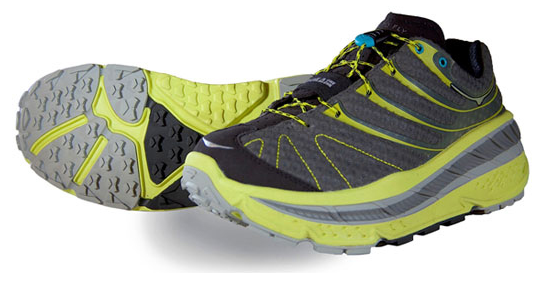 Hoka One One Stinson EVOLast year I wrote a piece on running different. In it, I focused on the impact that the barefoot running movement has had on running technique. It’s not like the technique is new or even “lost”. It’s just that the jogging craze of the 70’s popularized heel striking and things went downhill from there.
Hoka One One Stinson EVOLast year I wrote a piece on running different. In it, I focused on the impact that the barefoot running movement has had on running technique. It’s not like the technique is new or even “lost”. It’s just that the jogging craze of the 70’s popularized heel striking and things went downhill from there.
Minimalist Review
The new school running movement of late brought back mid and fore foot striking and, I believe, we’re all better for it. What I did NOT do in that essay was embrace barefoot and minimalist shoes. Thank god because what I’m going to share with you here would be even more scandalous if I had.
To review, my contentions in Running Different is that minimal or barefoot running technique nearly demands that runners adopt a midfoot or forefoot striking gait. This is a good thing. But I went on to point out the perils of this footwear when traveling off road. Foot protection and sticky rubber are things that can enhance, not detract from the trail running experience. Not to mention the significant injury potential of running with minimal protection. I conclude that it is the technique and not the shoe that is important.
Running Longevity
Decades ago I was shopping with a friend who wanted to buy a pair of hiking boots. This was at a time when people were starting to lighten up their kit when traveling in the mountains. This guy made a comment that always stuck with me. He said that he was unimpressed with the super light footwear movement. He wanted to be hiking long into old age and felt that his feet would suffer over the long term wearing shoes with minimal protection. He had a point.
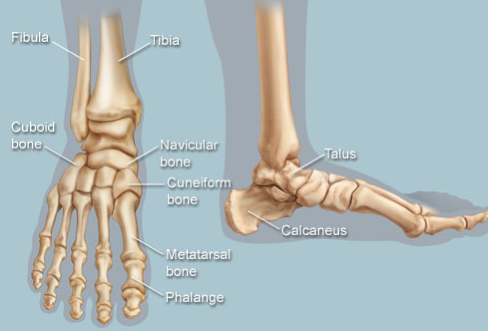 Plenty of things to wear outNow, you don’t have to be an orthopedic surgeon to realize that the beating our feet take playing in the mountains might have some degenerative consequences on our joints. Hips, knees, ankle and feet all suffer the abuse. As a population, we are shod from birth and so our feet are particularly vulnerable. Add race pace aggression on a downhill and suddenly being barefoot or lightly shod no longer seems like such a good idea.
Plenty of things to wear outNow, you don’t have to be an orthopedic surgeon to realize that the beating our feet take playing in the mountains might have some degenerative consequences on our joints. Hips, knees, ankle and feet all suffer the abuse. As a population, we are shod from birth and so our feet are particularly vulnerable. Add race pace aggression on a downhill and suddenly being barefoot or lightly shod no longer seems like such a good idea.
At one end of the modern shoe quiver are kicks like the Vibram Five Finger and the Merrel Barefoot Trail Glove. These have their place. Not a bad idea for walking around town, the beach, water sports or the weight room. 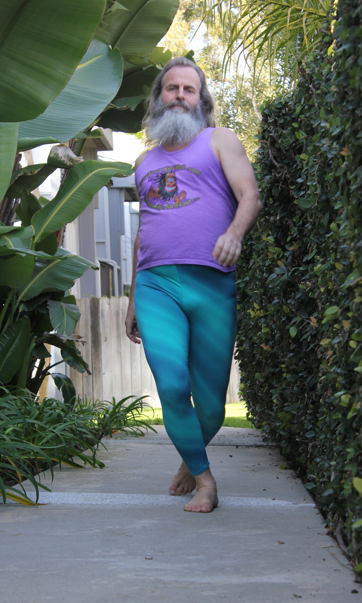 Barefoot Bob - barefoot running celebrity. Of course he has a crazy beard.But for trail running, I think they’re stupid. That said, I still see plenty of folks out there running in them in the hills, proving a point, looking all groovy and shit like tele skiers back in the 80’s (see photo above).
Barefoot Bob - barefoot running celebrity. Of course he has a crazy beard.But for trail running, I think they’re stupid. That said, I still see plenty of folks out there running in them in the hills, proving a point, looking all groovy and shit like tele skiers back in the 80’s (see photo above).
Just as I’m an admitted recovered telemark skier, I ran in the woods once in Five Fingers. I moved like a freaking Ninja from Teton Village up Granite Canyon to the top of the tram. Took me about 2.5 hours. Sure, I felt pretty neat for the first few miles. “Hey, look at me. I’m a soul runner!” But by the time I got to the top I just felt like an asshole…one who’s feet felt like they’d been caned like a 19th century Malasian juvenile delinquent who got caught trying to run away from boarding school. I could barely walk. Thank god I could ride the tram down.
Diving In
For the last season or two I've utilized shoes a notch or two up from these thin-soled options. I wanted some protection and a lug sole for running in the mud. You can read my review of these here. My feet still hurt after long outings but I figured that was just part of the deal. Or was it?
Every time I went to the shoe store to see what was new, a brand of shoes representing the other end of the spectrum never failed to grab my attention. Of course, I’m referring to the Hoka One One (pronounced hoe-kah oh-nay oh-nay, Maori for “time to fly”). 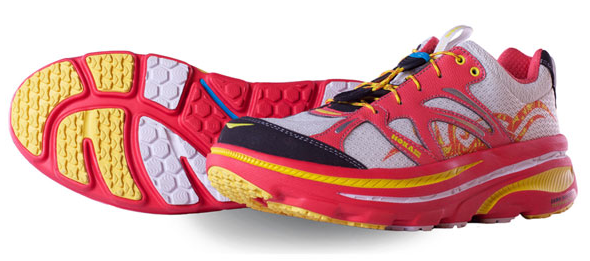 Hoka Bondi SpeedThese pillow-soled beasts looked ridiculous to me with their 6 cm of EVA sole under the heel. I always asked a few questions about them, even ran on the treadmill a time or two but just couldn’t get myself to commit the $160 to check them out.
Hoka Bondi SpeedThese pillow-soled beasts looked ridiculous to me with their 6 cm of EVA sole under the heel. I always asked a few questions about them, even ran on the treadmill a time or two but just couldn’t get myself to commit the $160 to check them out.
Still, the idea of that kind of protection under foot continued to occupy my thoughts, even more so after long runs that left my dogs barking. I sheepishly raised the topic with one of my experienced running friends, a guy with a track pedigree. He scoffed and questioned my sexual orientation when I mentioned the Twinkie Shoes. I really felt like I was swimming up stream here.
After a couple of friends stepped up for them and sang their praises, I started researching more. I discovered a few high level ultra runners using them and that pushed me over the brink. It was time to check them out.
Hoka makes several models and I decided on the most off-road friendly one, the Stinson EVO. I now have 34 hours on them. I’ve covered everything from pure asphalt to technical 4th class ridge traverses. Murder Traverse test driveI even did the Alyeska Climbathon in them. That’s 23,500 vertical feet of ascending over 9 hours. My overall impression continues to be positive. Hokas are not the perfect shoe because such a beast doesn’t exist. But they work surprisingly well in a variety of conditions and excel in a few others.
One of the first things a salesman will point out about the Hokas when a customer gawks at the thick sole is that the shoes are “minimal” in a sense. No, they’re not bare foot minimal but they are “rise” minimal. In fact, they claim only a 4mm delta. That’s pretty damn flat. Although the heel looks super beefy and much higher than the front end, the foot actually sits down inside a pocket in back so the relative height is less.
But the wearer is higher and this brings my number one concern to light – stability. I was afraid that I'd be more prone to rolling my already dicey ankles. In truth, the shoes seem to be more, not less, stable. This is due to the wider footprint and cushy nature of the sole. The idea is that with a firm sole, any uneven rock deflection potentially generates lateral torque, creating the dreaded ankle roll. Hokas, with their soft mid-sole material, deforms rather than deflects and slows the moment of sketchy angular acceleration. This creates stability. As one guy puts it, they’re full suspension for your feet.
The beauty of this kind of protection is that you can worry less about each foot fall and simply steam roll pesky trail surfaces. The result are feet that feel less beat up at the end of a long run.
On technical terrain the squishy soles create additional traction by grabbing hold of rock irregularities. The rubber compound itself also seems pretty sticky. On slabby terrain, you can’t really edge but by simply turning your feet in and smearing heels down, you can easily negotiate most slabs.
The only time I regret the high volume of the sole material is when I’m contouring along steep slopes. This is the one time when I feel top heavy. I remedy this by finding flat areas to place my foot. 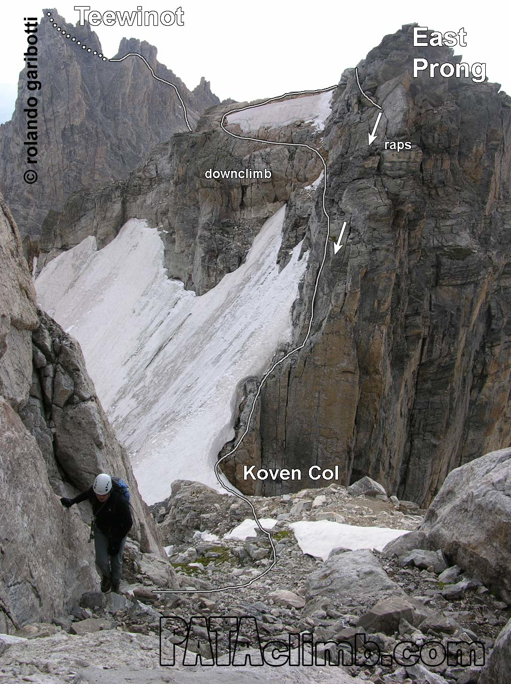 Not Hoka terrain. photo courtesy of Rolando GaribottiSo, if I was doing something like the Cathedral Traverse in the Tetons, Hokas would not be the shoe of choice. Of course, there are few true running shoes that I would use on such an undertaking so the point is really moot.
Not Hoka terrain. photo courtesy of Rolando GaribottiSo, if I was doing something like the Cathedral Traverse in the Tetons, Hokas would not be the shoe of choice. Of course, there are few true running shoes that I would use on such an undertaking so the point is really moot.
My friend, ultra running bad ass and fellow orthopedic physician assistant, Luke Nelson, has some reservations with Hokas pertaining to certain types of overuse injuries. He has no data for this but has seen a few runners come up lame using the Twinkie shoes. Certainly possible. But the vast majority of testimonials I read in my research suggest that most peoples’ injuries improve with the shoes. I think they’re worth a look.
In conclusion, I would say that for an aging athlete like me with the usual orthopedic wear and tear, Hokas are a great choice for softening the blow of running. And for the young studs out there? Perhaps taking care of your dogs now will keep you running longer. Just sayin’…
 Brian |
Brian |  16 Comments |
16 Comments |  Hoka,
Hoka,  barefoot running,
barefoot running,  mountain running,
mountain running,  tetons in
tetons in  Gear
Gear 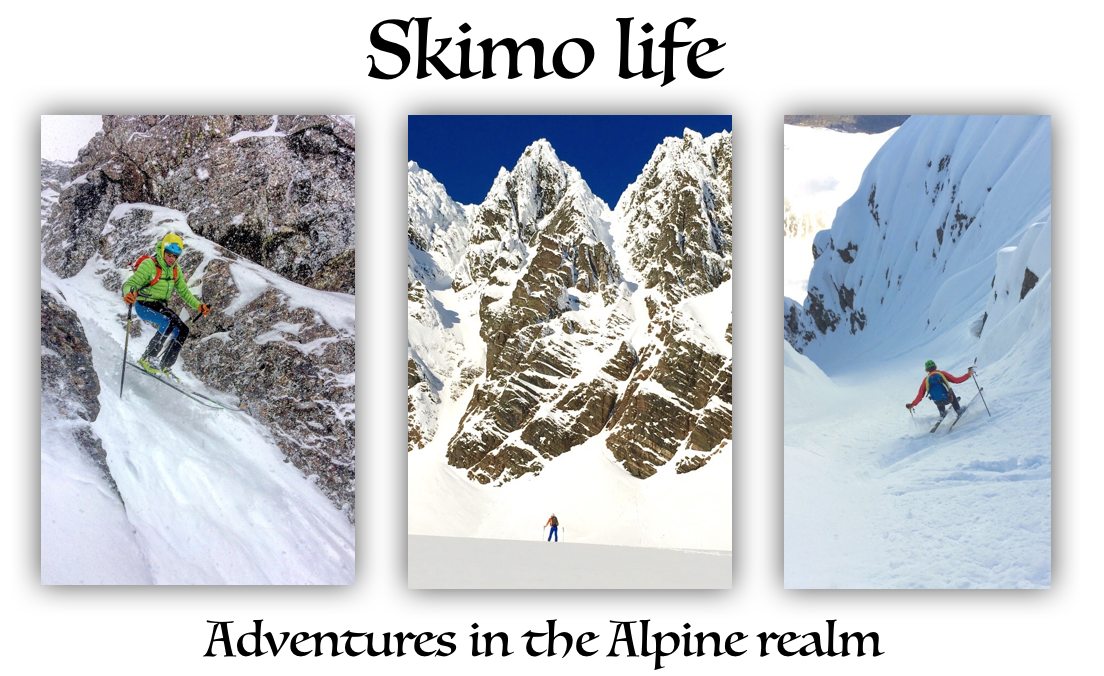



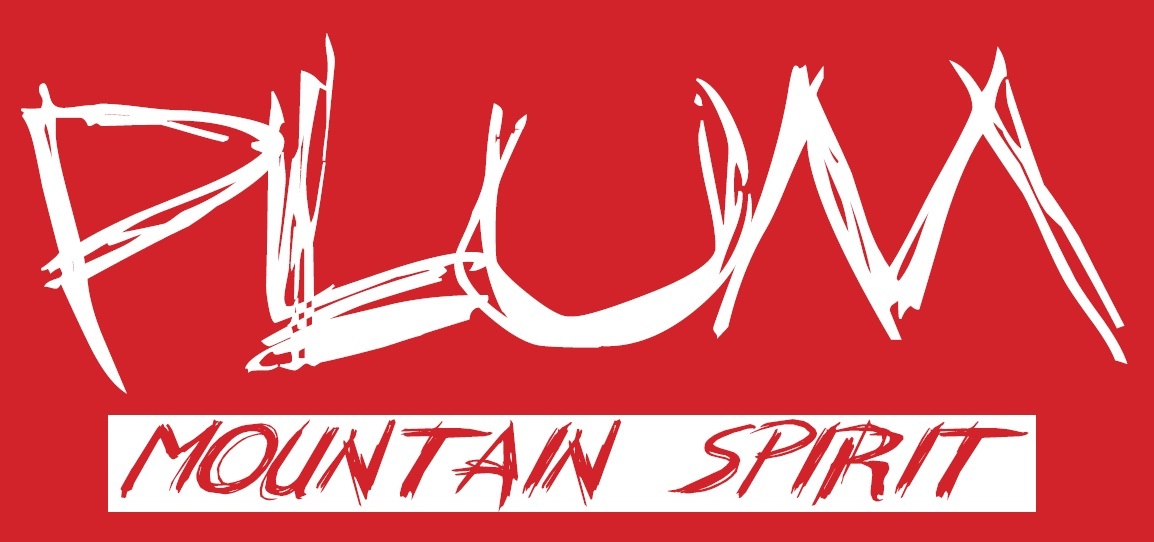

Reader Comments (16)
The money quote: "it is the technique and not the shoe that is important." As with so much in life, spending time to actually learn how to do something is key. Most people, typically Americans, would prefer to spend money rather than time.
Nice post, mate. I always enjoy reading your iconoclastic, self-guinea pigging.
Thanks for the review. I think I will give them a try...two reasons. 1. I love trail running and hope to continue to do it into old age, maybe they will help. 2. I have been passed by people wearing them in the last three trail races I participated in. It's interesting you used them in the climbathon as I have heard that some people don't like them as much for the uphills but rave about them on the downs, but I guess with such a huge day the added protection makes up for it. Thanks again.
I have a 100 percent ankle-roll rate with Hokas. I would love it if I could use them, but sadly, I can't.
And running on sidehills with the high soles is really hard.
Funny how gear reviews always generate the most comments.
Like I said, they're not for everyone, Jared. We've had this discussion. But for me, I actually stopped wearing my ankle brace with the Hokas. Go figure. Of course, it might be that I'm just more careful with them. As for side hills, I don't have to do that much trail running but I agree they are less ideal in that scenario.
I used them on the uphill race for the protection. I could have used a lighter shoe, for sure, but the trail is pretty rocky and my feet loved the cushion over the course of the day. Huge difference.
I did one training day (5 laps) with thin shoes and one in the Hokas and the difference in my leg and foot comfort was startling.
I'm convinced ....I'll find them in Seattle and check them out.
Hi Brian, Love the blog. It's awesome to see how hard you get after it in the mountains year after year after year.
Question about Hokas - How durable have you found them to be? I put about 100 miles on a pair then did the San Juan Solstice in them (50 miles, 13,000 ft gain and loss). After that race, they were done. It was as if my right inside heel had a flat tire. I can't wear them even for a short run now, because it causes my ankle to turn unnaturally inward.
I loved the Hokas - I was able to hammer out lots of miles and vertical without any knee pain, which had been a problem in the past. But for $150+, I would expect them to last a little longer than 150 trail miles.
Your thoughts?
Curious to hear what you think, Cindy. You might like them. Good for all the urban hiking you do around Seattle. There are models made for pavement that have even more cushion. Let me know.
That's disappointing to hear, Ed. How heavy are you? I have 35 hours in mine and they seem fine. Haven't noticed much breakdown yet. I have read other comments that they seem to hold up.
If I were you I would contact the company and send them back. Most of the companies stand behind their products when a customer takes the time to write a letter and pursue satisfaction. Give it a go and let me know what you turn up.
I queried the company about getting a free pair in exchange for a piece like I just wrote. Seemed like a pretty good trade. But I never heard a word. Maybe my contact was bad.
Thanks for the reply Brian. I'm about 185 lbs, so I can't imagine that would've caused the shoes to blow out. I'm thinking I just got a faulty right shoe... I forgot to mention that the tread is also peeling off as well. I'll look into sending them back and let you know how it goes.
In the meantime, I saw this article the other day and thought you might find it interesting (if you haven't already seen it):
http://blog.ultimatedirection.com/gannet-the-grand-a-wyoming-whirlwind-tour/
This guy is really taking mountain running to a new level.
Ed,
You're a pretty big dude for a runner but that shouldn't cause one shoe to destruct. That said, I have found that heavier athletes destroy the soles on La Sportiva Electrons while lighter runners have no issues.
But definitely warrantee those guys. I wouldn't take no for an answer.
Check out Kilian's Quest season 4 Episode 4 and 5 with Tony Krupika running in the Tetons. That 4 hours off the Gannet time is ridiculous!
Brian, you referrred to Luke mentioning injury patterns with these shoes.....what were the specific injuries? I'm sloooooowly recovering from an achilles tendonosis that I am convince was due to my season of experimenting with minimalist shoes. Just curious which injuries he is seeing with these shoes? I've been looking into them.
Hi Ray,
Luke didn't say and I didn't ask.
I think you can be confident that your Achilles issue is due to the style of running more than the shoes. As I pointed out in my Running Different piece last year, the "new school" style, with it's forefoot and midfoot heavy striking, creates a different stress on the lower extremity than heel striking. I had a partial tear of my gastroc for my initiation. All good now.
Definitely don't ignore your condition as that kind of chronic tendonosis can lead to rupture in some folks. Not good. As an aside, there may be some evidence that the ultra sound bone growth stimulators in use may help with tendon healing. You could have a look. Worth a try.
As for Hokas solving your problem, hard to say. They certainly ease the pounding but you will still be running on your toes. You only have $160 to lose. Give 'em a whirl.
Brian, I definitely don't expect a magic bullet! I bought a pair of the Hokas and they are amazing! Granted, I'm still doing "low" milieage....
FYI, my tendonosis occured cuz I fell into the minimalist shoe trap. Granted, it was partly my fault as I didn't ease into it (i.e. cut my mileage down and then biuld it back up). I've always naturally ran with a midfoot strike, so there wasn't really much of a change in running style for me.
An interesting side note...I stopped running for 1.5yrs and started gradually biulding up my mileage this summer. I noticed some interesting things and did my own little experiment with the two types of shoes I've been running with....the Montrail Fairhaven and Montrail Mtn Masochist (two very different shoes). I did two weeks of running on the Fairhavens and two on the Masochists, alternating two week periods over two monhs (running on the same terrain and not changing the mileage..i.e. 5-8mi). The difference was amazing. No achilles pain with the Fiarhavens, and soreness after every run with the Masochists. Did a gait analysis, running in each shoe, and the Masochist was causing me to pronate a LOT to the lateral side and then rolling medially when moving to the push off. Just looking at it, and not knowing a damn thing about biomechanics, was pretty eye opening. When I ran on the Fairhavens there was no pronation, and it looked like nice, pretty foot strikes....needless to say, I was cringing with each step when watching the video in the Masochist. haha. Went back with the Hokas and did an assessment also and they seem to be doing the same thing....i.e. causing a more level foot strike. It kinda sold me on getting a gait assessment done when buying a shoe. Not a guarantee, but at least it will point out when it is obviously the wrong shoe......
I ran in the Stinson EVO for several months. I have been running the mountains and trails for 30+ years and these shoes are the first shoes that caused me numerous blsiters on my feet -- a real blister factory (with or without the additional foot bed). I loved them going down hill but always felt the uphill was more of a chore due to the cushion and the associated energy disbursement.
I wanted them to work, but in the end there are definitely not for me.
Well, there we go. These last two comments demonstrate the rub with shoes (no pun intended, David). It's expensive to experiment but damn fun. Buying new shoes is very therapeutic for me. Consumer whore, I guess. But you need to do it in order to find the ones that work.
Since I've been back in AK I've been running the steep hills for only an hour or two and doing so in Salomon Fell Cross. They have better soles for mud. I feel the rocks more but my feet didn't hate it. They also feel light. That said, I think the Hokas really excel at long trail runs. I will continue to experiment and mix it up. I have a couple of others by Adidas and Inov 8 in my sites.
Thanks for the input, Ray and David. So cool to hear everyone's impressions
Nice post. Keep in mind before buying these that the top of the back of the shoe comes up much higher on the Achilles than regular runners... My new Hoka's have blistered the heck out of both ankles and now I have to wrap bunion cushions with tape over unhealed blisters, and wear HIGH tight socks (otherwise the top of the sock ads to the rubbing) to reduce the rubbing. A month or more of wearing in and they still hurt. The BOTTOMs of my feet don't hurt anymore, yay, but Hoka has to do something about the Achilles area issue. Changing to an inside fabric that isn't like sandpaper would be a good start.
This problem could be due to particular anatomic issues on your feet. I'd be curious to see how many users have experienced similar problems.